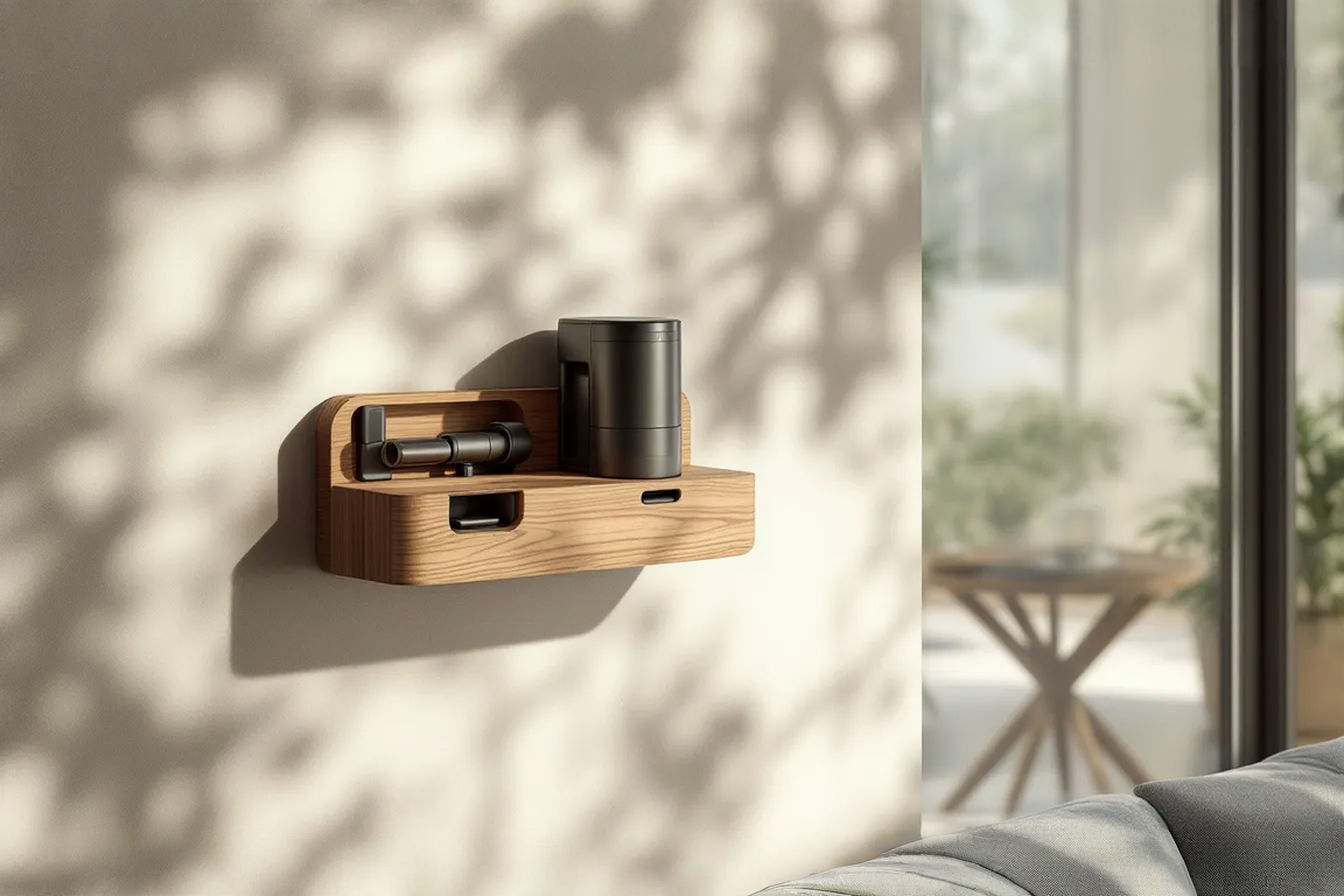Cordless Vacuum Charging Station Design: Creating Functional Power Bases That Don’t Disrupt Decor
Discover how to design cordless vacuum charging stations that perfectly balance functionality with aesthetics, turning a necessary eyesore into a thoughtful element of your home’s design.
This post may contain affiliate links. If you make a purchase through these links, we may earn a commission at no additional cost to you.
In today’s home, the cordless vacuum represents a significant upgrade from its corded ancestors. These sleek cleaning devices offer unprecedented freedom and maneuverability, yet they bring a new challenge: where and how to charge them without creating visual clutter. The charging station, often an afterthought in the purchase decision, frequently becomes an eyesore in otherwise carefully designed spaces.
Finding harmony between functionality and aesthetics has become a genuine concern for homeowners who value both clean floors and clean design lines. The standard-issue charging docks that accompany most cordless vacuums rarely consider home decor, instead prioritizing only basic charging functionality. These utilitarian power bases, with their industrial appearance and tangle of cords, can disrupt the visual flow of living spaces.
The popularity of cordless cleaning tools continues to surge, with brands like Dyson, Shark, and Bissell competing for counter and floor space in millions of homes. As these devices become permanent fixtures in our living environments, the need for thoughtfully designed charging solutions grows proportionally. Many homeowners face common pain points: bulky charging bases that don’t fit discretely in any space, cord management issues, and the visual discord of technical equipment in carefully curated rooms.
This comprehensive guide tackles the challenge of creating vacuum charging stations that serve their practical purpose while respecting your home’s design integrity. We’ll explore various approaches to power base design, from simple cosmetic improvements to complete custom integrations. The perfect charging solution exists at the intersection of technical requirements, space utilization, and aesthetic consideration—a junction we’ll help you navigate with confidence.
Whether you’re seeking a weekend DIY project or planning a more integrated storage system, the following sections will walk you through key considerations, creative options, and practical implementations that transform the necessary evil of vacuum charging into a thoughtful element of your home’s design language.
1. Understanding Charging Requirements
Before diving into aesthetic considerations, we must acknowledge the technical foundation of any charging station design. A vacuum power base serves a critical function that directly impacts the performance and longevity of your cleaning tool. Creating a charging solution that prioritizes form over function could lead to reduced battery life or even safety hazards.
Technical Needs for Proper Charging
Most cordless vacuums require specific power conditions to charge optimally. Voltage and amperage requirements vary between manufacturers and even between models from the same brand. Always refer to the technical specifications provided with your device to ensure your charging station design can accommodate these needs. Adapting a charging base without understanding these requirements risks damaging sensitive electronic components.
Ventilation represents another crucial consideration often overlooked in custom charging solutions. Many vacuum batteries generate significant heat during charging, requiring adequate airflow to dissipate this thermal energy. Designs that completely enclose the charging mechanism may trap heat, potentially shortening battery lifespan or creating fire hazards. Your charging station should incorporate ventilation channels or openings, particularly if the vacuum will charge inside a cabinet or closed space.
Manufacturers typically recommend specific charging practices to maximize battery performance and longevity. Some models benefit from constant connection to power, while others perform better with periodic complete discharge cycles. Your charging station design should facilitate these recommended practices rather than hindering them. A beautiful charging solution becomes counterproductive if it reduces the useful life of your expensive vacuum.
Connection Types and Compatibility
Charging interfaces vary significantly across vacuum brands and models. Some utilize direct-connect systems where the vacuum body itself plugs into the power source, while others employ dock-style chargers where the unit sits on or hangs from a powered base. Each connection type brings distinct design considerations for your charging station. The dock-style chargers typically require more thoughtful integration, as they present larger elements to conceal or incorporate into your decor.
Wall adapters and integrated power bases represent two common approaches to cordless vacuum charging. Wall adapters offer flexibility but introduce cord management challenges, while integrated bases provide a cleaner appearance but require more permanent installation. Your charging station design should address the specific connection style of your vacuum while maintaining easy access for daily use.
Accessibility to charging indicators deserves careful attention in any power base design. Most cordless vacuums provide visual feedback about charging status through LED lights or display screens. Your charging solution should maintain visibility of these indicators, allowing you to confirm proper connection and monitor charging progress without dismantling your storage system. Some sophisticated designs incorporate light pipes or transparent elements to relay these indicator signals to visible locations.
2. Types of Charging Stations
The variety of charging station designs continues to expand as homeowners seek solutions that better align with their spaces and aesthetic preferences. Each approach offers distinct advantages and challenges, from wall-mounted systems that free up floor space to furniture-integrated options that completely conceal charging functionality. The ideal type for your home depends on available space, vacuum specifications, and your personal design sensibilities.
Wall-Mounted Options
Wall-mounted vacuum docking stations provide one of the most space-efficient charging solutions, particularly beneficial in smaller homes and apartments. These systems elevate your cleaning tool off the floor, creating a floating effect that minimizes footprint while keeping the vacuum easily accessible. Many homeowners find that wall mounting transforms their vacuum from floor clutter into a deliberate design element, especially when installed with careful consideration of sight lines and traffic patterns.
Installation requirements represent a primary consideration for wall-mounted designs. Most cordless vacuums weigh between 5-10 pounds, necessitating secure attachment to wall studs or the use of appropriate anchors. Your mounting system must accommodate both the vacuum’s weight and the additional forces applied when attaching or removing the device from its dock. Reinforced mounting plates or custom brackets often provide the necessary stability for daily use.
Visibility concerns naturally arise with wall-mounted solutions, as they place your vacuum in plain sight. This approach works best when the vacuum itself has attractive design qualities worth showcasing, such as many Dyson models with their distinctive engineering aesthetics. For less visually appealing models, wall-mounted systems can incorporate decorative shields, cabinets with doors, or strategic placement in less prominent locations such as utility rooms or walk-in closets.
Freestanding Designs
Floor-based charging stations offer maximum flexibility with minimal commitment, allowing you to position your vacuum charging area wherever makes the most sense at any given time. These freestanding designs range from simple docking stands to elaborate multi-function cabinets. The primary advantage lies in their mobility—they can be relocated as needs change or during home reconfigurations, making them ideal for renters or those who frequently redecorate.
Furniture-integrated options represent a more sophisticated approach to freestanding design. These might include side tables with hidden charging compartments, storage ottomans with internal power access, or decorative screens that conceal vacuum storage areas. The dual functionality of these pieces justifies their presence in living spaces, eliminating the need to dedicate floor area solely to vacuum storage.
Portable charging bases provide an interesting middle ground, offering the simplicity of a dedicated charging station with the freedom to relocate as needed. These lightweight docks often incorporate carrying handles or wheels for easy transportation between rooms or storage areas. Some clever designs double as transport carts for the vacuum and its attachments, combining charging functionality with mobility in a single, efficient package.
Hidden and Convertible Solutions
For those who prefer to keep cleaning tools completely out of sight, closet and cabinet integration offers an ideal solution. These systems tuck your vacuum charging base inside existing storage areas, utilizing space that might otherwise remain underused. Successful closet integrations typically incorporate power supply management, ensuring the charging cord reaches an outlet without creating tripping hazards or pinch points when closing doors.
Pull-out drawer systems represent one of the most elegant hidden charging solutions, completely concealing the vacuum when not in use while providing effortless access when needed. These custom drawers, typically installed in kitchen cabinets or hallway storage units, often include integrated outlets and dedicated spaces for attachments. The primary challenge involves designing drawer slides robust enough to support the vacuum’s weight while maintaining smooth operation over years of use.
Furniture with built-in charging capabilities provides perhaps the most seamless integration of vacuum storage into living spaces. Custom pieces designed specifically for this purpose can match your existing decor while incorporating all necessary technical elements discreetly. From hall trees with hidden vacuum compartments to media centers with dedicated cleaning tool sections, these specialized furnishings eliminate the compromise between practicality and aesthetics.
3. Materials and Aesthetics
The visual impact of your vacuum charging station depends largely on material choices and design details. Thoughtful selection of construction materials not only affects appearance but also influences durability, functionality, and compatibility with your vacuum’s technical needs. The most successful charging stations achieve a seamless blend with surrounding decor while maintaining perfect functionality.
Material Selection for Visual Appeal
Wood remains the most popular material for custom charging stations due to its warmth, versatility, and timeless appeal. From rustic pine to sophisticated walnut, wooden charging solutions can adapt to virtually any design style. The natural variation in grain patterns adds visual interest even to simple designs, while the material’s workability allows for complex customization. Wood does require consideration of thickness and reinforcement when supporting heavier vacuum models.
Metal elements introduce contemporary flair and exceptional durability to charging station designs. Aluminum profiles, steel supports, and brass accents can elevate a basic storage solution into a statement piece. Metal components excel in areas requiring structural strength while maintaining minimal visual weight. The combination of wood and metal often yields the perfect balance of warmth and industrial appeal, particularly effective in modern and transitional interiors.
Plastic and composite materials offer affordable, lightweight alternatives that excel in moisture-resistant applications like bathroom or mudroom charging stations. Modern manufacturing techniques produce remarkably convincing wood-look composites that withstand humid environments far better than genuine timber. For DIY projects, these materials often provide the simplest fabrication process, requiring minimal specialized tools or finishing techniques.
Finish and Texture Choices
The finish applied to your charging station dramatically influences how it relates to surrounding decor. Paint offers unlimited color matching potential, allowing your storage solution to exactly match existing walls or furniture. Stained finishes highlight the natural character of wood while adjusting its color tone to complement your space. Natural finishes like clear oils or waxes provide protective benefits while showcasing the authentic appearance of quality materials.
Texture decisions impact both the tactile experience and visual character of your charging station. Smooth surfaces project contemporary sophistication and facilitate easy cleaning, particularly important around devices that collect dust. Textured finishes introduce visual complexity and help disguise minor damage from daily use. The contrast between different texture zones can create visual interest even within monochromatic designs.
Different aesthetic traditions suggest distinct approaches to charging station design. Weathered finishes align perfectly with farmhouse and coastal styles, often employing distressing techniques or whitewashed treatments. Modern aesthetics typically favor clean lines and minimal ornamentation, with emphasis on material quality rather than decorative elements. Traditional styles might incorporate carved details or reference historical furniture forms to maintain design continuity.
Color Psychology in Storage Design
The color strategy for your charging station significantly impacts its visual presence in your space. Blending approaches use colors nearly identical to surrounding walls or furniture, causing the charging station to recede visually into the background. This technique effectively minimizes the visual impact of utilitarian objects that serve purely functional purposes in your design scheme.
Statement pieces take the opposite approach, using contrasting colors or bold finishes to transform the charging station into a deliberate design element. This strategy works particularly well with architecturally interesting vacuum models or when the charging station incorporates additional decorative functions like display shelving or artwork integration.
Neutral palettes offer maximum versatility in changing design environments. Grays, taupes, and soft whites adapt easily to evolving color schemes and facilitate future decor changes without requiring replacement of built-in elements. When designing more permanent charging solutions, these adaptable colors provide insurance against future redecorating projects, ensuring your practical investment remains visually relevant for years to come.
4. Space-Efficient Design Solutions
In today’s homes where square footage comes at a premium, space-efficient charging solutions prove especially valuable. The challenge intensifies in smaller living environments where every inch matters. Creative approaches to vacuum storage can transform even the most compact spaces into functional charging zones without sacrificing style or convenience.
Small Apartment Solutions
Dual-purpose furniture represents an ideal strategy for apartment dwellers seeking to maximize functionality in limited space. Side tables with internal charging compartments, storage benches with power access, or room dividers with integrated vacuum docks allow a single piece to serve multiple functions. These multifunctional items justify their footprint through versatility, eliminating the need for dedicated storage space.
Vertical storage approaches utilize wall height instead of floor area, a particularly valuable strategy in compact living situations. Wall-mounted charging stations, over-door hanging systems, and tall, narrow cabinets capitalize on typically underutilized vertical space. These solutions keep vacuums and their charging components accessible while maintaining precious floor area for living and circulation.
Minimalist charging stands focus on reducing the visual and physical footprint of necessary equipment. These streamlined designs strip away everything non-essential, resulting in elegant, simple solutions that support the vacuum without unnecessary bulk. Often constructed from bent metal or slender wood components, these minimal approaches provide maximum function with minimum material, ideal for visual lightness in small spaces.
Closet and Utility Room Integration
Custom shelving options transform standard closets into efficient charging zones for cordless vacuums. Adjustable shelf systems can accommodate various vacuum heights while providing dedicated space for attachments and accessories. The key to successful closet integration lies in power management—installing outlets at appropriate heights or creating cord pathways to existing power sources without creating tripping hazards.
Door-mounted solutions maximize often-forgotten space on the interior side of closet or utility room doors. These systems typically employ brackets or hanging organizers attached directly to the door, transforming dead space into functional storage. The door-mounting approach keeps vacuums readily accessible while maintaining clean sightlines in the main closet or room when the door remains closed.
Pull-out systems combine the convenience of full-extension drawer slides with customized vacuum support structures. These clever solutions keep charging vacuums completely hidden when not in use while providing effortless access when needed. The sliding mechanism eliminates the need to reach deep into cabinets or closets, making this approach particularly valuable for users with mobility limitations or in awkwardly shaped storage areas.
Kitchen and Pantry Approaches
Creating dedicated cleaning tool zones within kitchen cabinetry centralizes household maintenance equipment in a logical location. Many homeowners find that positioning vacuum charging stations near other cleaning supplies creates intuitive workflow patterns. These specialized cabinet sections often incorporate additional features like attachment organizers, supply storage, or pull-out work surfaces for maintenance tasks.
Under-counter charging options utilize the toe-kick space beneath standard kitchen cabinets, an area typically wasted in most kitchens. Custom drawer systems installed in this zone can house stick vacuums horizontally, keeping them charged, protected, and easily accessible without consuming valuable cabinet space above. This approach requires careful planning for power supply and may involve minor modifications to existing cabinetry.
Pantry door organization systems transform the inside of pantry doors into highly functional storage zones. Wire racks, custom brackets, or specialized holders mounted to the door interior can support charging vacuum bases while keeping the devices easily accessible. This approach works particularly well for apartments or smaller homes where dedicated utility rooms don’t exist, allowing cleaning tools to share space with food storage without cross-contamination concerns.
5. DIY Charging Station Projects
Creating your own vacuum charging solution offers both practical and creative satisfaction. DIY approaches range from simple weekend projects requiring basic tools to sophisticated custom builds demanding advanced woodworking skills. Regardless of complexity, the personal satisfaction of solving a design challenge with your own hands adds special value to these homemade charging stations.
Simple Weekend Projects
Basic wall mount construction represents perhaps the most accessible DIY charging solution. Using readily available materials from home improvement stores, you can create a simple but effective wall-mounted dock in just a few hours. The simplest version might consist of a wooden backplate with appropriately sized hooks or brackets to support your specific vacuum model. Adding a small shelf for the power adapter and a simple cord management system elevates the functionality without significantly increasing complexity.
Repurposed furniture techniques transform existing pieces into specialized vacuum charging stations. Old nightstands, narrow bookcases, or unused kitchen cabinets provide excellent starting points for these conversion projects. The repurposing approach typically involves adding internal cutouts for power cords, mounting specific support brackets for your vacuum model, and potentially modifying doors or drawers to accommodate the vacuum’s dimensions. This sustainable strategy gives new life to underutilized furniture while solving a practical storage need.
Tool-free assembly options appeal to apartment dwellers or those with limited DIY experience. These projects utilize components like tension rods, command strips, over-door hangers, or modular cube systems to create functional charging stations without permanent modifications. The non-destructive nature of these approaches makes them ideal for rental situations or for those who prefer flexibility to relocate their charging solution as needs change.
Intermediate Woodworking Approaches
Custom cabinetry projects provide tailored storage perfectly suited to your specific vacuum model and space requirements. These intermediate-level builds typically involve constructing a basic cabinet frame, fabricating door components, and installing specialized interior fittings. The freedom to specify exact dimensions and features results in charging stations that maximize efficiency while complementing your home’s architectural details and design style.
Floating shelf designs with hidden charging capabilities offer a sophisticated solution that conceals the utilitarian function behind clean, decorative forms. These projects often incorporate false backs or underside compartments where charging components remain hidden while in use. The technical challenge involves creating secure wall mounting that supports both the shelf structure and the weight of the vacuum, typically requiring locating wall studs or using appropriate heavy-duty anchors.
Decorative screen and panel systems provide partial visual separation while maintaining necessary airflow around charging components. These semi-transparent dividers can transform a visible vacuum charging area into an intentional design feature. Construction typically involves creating a frame structure supporting interchangeable panels of various materials—perforated metal, lattice wood, woven natural fibers, or decorative acrylic. The visual porosity of these screens allows you to glimpse the vacuum’s presence without experiencing its full visual impact.
Advanced Custom Solutions
Built-in home automation options represent the cutting edge of DIY charging station projects. These sophisticated systems might incorporate programmable power timers, wireless charging status indicators, or integration with smart home platforms. The automation elements allow you to optimize charging cycles, receive maintenance alerts, or control power consumption remotely. While technically challenging, these advanced features particularly benefit households with multiple battery-powered devices managing complex charging schedules.
Integrated lighting and indicators transform basic charging stations into information centers for vacuum maintenance. LED strips indicating charging status, motion-activated compartment lighting, or illuminated storage sections for attachments add both functionality and visual interest. These lighting elements can connect to existing charging indicators or operate independently through separate power systems, depending on your technical comfort level and specific requirements.
Multi-function storage systems combine vacuum charging with broader organization needs, creating comprehensive solutions for household management. These ambitious projects might integrate mail sorting, key storage, backpack hanging, or seasonal item rotation alongside vacuum charging functionality. The design complexity increases substantially with each added function, requiring careful planning of traffic patterns, access frequency, and component relationships.
6. Brand-Specific Design Considerations
Different vacuum brands present unique design challenges for charging station creation. The variation in charging mechanisms, body shapes, and attachment systems necessitates tailored approaches for popular manufacturers. Understanding these brand-specific considerations helps you create a charging solution perfectly matched to your particular vacuum model.
Dyson Design Solutions
Accommodating Dyson’s unique charging connectors requires careful attention to the interface between dock and device. Most Dyson stick vacuums feature a wall-mountable charging dock where the vacuum hangs vertically, connected through a specialized port. Your charging station must maintain proper alignment with this connection point while supporting the vacuum’s weight appropriately. Some DIY solutions incorporate the original Dyson wall mount within a larger decorative framework, ensuring reliable charging while enhancing aesthetics.
Attachment storage integration proves particularly important for Dyson owners, as these vacuums typically come with multiple specialized tools. The various brushes, crevice tools, and extension wands benefit from dedicated storage niches within your charging station design. Consider frequency of use when positioning these attachments, placing regular-use tools in easily accessible locations while storing specialty attachments in less prominent areas.
Aesthetic harmony with Dyson’s design language helps create a cohesive visual relationship between the vacuum and its storage solution. Dyson products typically feature bold, technical aesthetics with vibrant accent colors against neutral bases. Your charging station might incorporate similar color blocking, curved surfaces, or visible mechanical elements to establish design continuity. This approach transforms the vacuum from visual outlier to integral component of a unified system.
Shark and Bissell Approaches
Adapting to different charging base shapes presents a primary challenge when designing for Shark, Bissell, and similar brands. Unlike Dyson’s wall-hanging approach, these vacuums often use floor-based charging docks with specific footprints and connection orientations. Your charging station must accommodate these predetermined shapes while providing adequate ventilation and access. Consider creating precision cutouts in shelving or cabinet bases that allow the original charging dock to nest securely while remaining functionally unchanged.
Managing larger docking stations requires thoughtful space planning, particularly in smaller homes. Many Shark and Bissell models feature substantial base stations designed to charge the vacuum while storing attachments. Rather than fighting these larger footprints, successful charging stations often embrace and enhance them, creating dedicated zones that accommodate the complete system. Cabinet doors, sliding panels, or decorative curtains can conceal these larger stations when not in use.
Solutions for removable batteries offer an alternative approach for compatible models. Some newer Shark and Bissell vacuums feature batteries that can charge separately from the main vacuum body. This capability enables more flexible charging station designs, as only the compact battery needs access to power. Consider creating a dedicated charging drawer for batteries while storing the vacuum body and attachments separately, potentially in more space-efficient vertical orientations.
Budget Brand Accommodations
Versatile designs for changing vacuum models make particular sense for households using budget-friendly brands. As these vacuums typically have shorter lifespans or may be replaced more frequently, your charging station should accommodate easy substitution of different models. Adjustable support brackets, modifiable storage compartments, and standardized power management systems future-proof your investment against inevitable model changes.
Adapter management for multiple brands becomes essential in households with diverse vacuum collections. Different manufacturers utilize various power adapter designs, voltage requirements, and connector types. Effective charging stations for mixed brand environments often incorporate labeled adapter storage, standardized cord lengths, and potentially dedicated power strips with individual switches for each device. This organized approach prevents the frustrating search for the correct adapter when charging time arrives.
Future-proofing your charging station acknowledges the rapid evolution of cordless vacuum technology. Designs that incorporate adjustable components, modular storage sections, and accessible connection points accommodate potential upgrades without requiring complete replacement. Some forward-thinking charging stations include universal mounting systems with adjustable brackets that can adapt to various vacuum shapes as models change over time.
7. Multi-Device Charging Solutions
Modern households often maintain multiple cordless cleaning tools, each with specific charging requirements. Creating cohesive systems to manage this collection improves both functionality and visual harmony. Well-designed multi-device charging stations transform potential chaos into organized efficiency.
Family Household Approaches
Charging multiple vacuum types together requires strategic planning and configuration. Different family members may prefer different vacuum styles—perhaps a stick vacuum for quick cleanup alongside a robotic vacuum for automated maintenance. Effective family charging stations accommodate these varied needs while maintaining visual cohesion. Consider vertical stacking approaches where each device occupies its own height zone, or compartmentalized designs with dedicated sections for each vacuum type.
Organizing attachments across devices presents a particular challenge in multi-vacuum households. Different brands and models rarely share compatible tools, necessitating separate storage systems for each set. Color-coding strategies, labeled compartments, or dedicated drawers for each vacuum’s accessories prevent confusion and streamline the cleaning process. Some sophisticated designs incorporate visual inventory systems that make missing attachments immediately apparent.
Labeling and personalization strategies prove especially valuable in shared household environments. When multiple family members use different vacuums, clear identification prevents confusion and promotes accountability for proper charging and storage. Custom labels, color-coded zones, or even engraved name plates can designate individual responsibility for specific devices. This personalization not only improves organization but also encourages ownership of maintenance tasks.
Integrating Other Cordless Tools
Combining vacuum, mop, and handheld tool charging creates comprehensive cleaning centers rather than isolated storage solutions. Many households now maintain cordless stick vacuums alongside handheld units, cordless mops, and specialized surface cleaners. Integrated charging stations for this complete ecosystem bring efficiency to household maintenance routines. Consider workflow patterns when designing these stations, positioning frequently used devices in the most accessible locations.
Power management for multiple devices requires careful planning to prevent circuit overload or adapter confusion. Most homes limit the number of outlets available in any given area, necessitating strategic use of power strips, smart plugs, or integrated charging hubs. Some advanced charging stations incorporate internal wiring systems that connect multiple devices to a single wall outlet, maintaining a clean appearance while simplifying the electrical connection.
Centralizing cleaning tool storage offers significant efficiency advantages beyond simply charging convenience. When all maintenance tools share a common home, cleaning tasks flow more naturally without hunting for specific implements. The most successful multi-device stations consider the relationship between tools—positioning the vacuum near the dustpan, the mop adjacent to the spot cleaner—creating intuitive groupings that support common cleaning sequences.
Commercial Applications
Scaled solutions for business settings must address additional requirements beyond residential applications. Commercial environments often maintain multiple identical vacuums requiring simultaneous charging between shifts. These high-volume stations typically feature standardized docking positions, clear labeling systems, and robust construction to withstand frequent use. Consider maintenance access requirements when designing commercial charging solutions, ensuring easy serviceability of both the vacuums and the charging infrastructure.
Charging station security considerations take greater importance in commercial or public settings. Unlike residential applications where access remains limited to household members, business environments may require protection against unauthorized use or theft. Secure cabinet designs with lockable doors, tamper-resistant power connections, or dedicated charging rooms provide necessary protection in these situations. Some sophisticated systems incorporate check-out procedures or digital tracking to monitor device usage.
High-traffic design reinforcements ensure longevity in demanding commercial environments. Edge protection, corner reinforcement, and heavy-duty hardware withstand frequent impacts and constant use. Materials selection shifts toward maximum durability rather than residential aesthetics, with commercial-grade laminates, metal components, and replaceable wear surfaces. The most effective commercial charging stations balance these reinforced elements with necessary accessibility for daily use.
8. Maintenance and Adaptation
Even the most thoughtfully designed charging station requires periodic maintenance and occasional adaptation to changing needs. Establishing regular care routines and planning for future modifications extends the useful life of your storage solution while maintaining its aesthetic appeal.
Keeping Charging Stations Clean
Dust management strategies prevent the ironic situation of your cleaning tool’s home becoming a dust collection point. Regular surface cleaning, strategic placement away from high-dust activities, and thoughtful material selection all contribute to reduced maintenance requirements. Some innovative designs incorporate small vacuum attachment hooks near the charging base, encouraging quick cleanup of the station itself during regular vacuum usage.
Cable organization and replacement deserve particular attention in long-term maintenance planning. Charging cables represent common failure points in any electrical system, experiencing physical stress with each connection cycle. Your charging station should provide easy access to these cables for regular inspection and occasional replacement. Integrated cable management systems that prevent sharp bends or tension points extend cord lifespan while maintaining visual tidiness.
Surface cleaning and preservation techniques vary depending on your charging station’s construction materials. Wood surfaces benefit from appropriate periodic refinishing to prevent damage from cleaning chemicals or vacuum components. Metal elements may require occasional treatment to prevent oxidation, particularly in humid environments. Plastic and laminate surfaces generally demand the least maintenance but benefit from proper cleaning products that prevent clouding or discoloration over time.
Adapting to New Vacuum Purchases
Modular design approaches facilitate easy adaptation when upgrading your vacuum. Charging stations constructed with adjustable shelving, removable brackets, or reconfigurable compartments accommodate changing dimensions without complete replacement. Some forward-thinking designs incorporate standardized mounting plates with interchangeable vacuum-specific brackets, allowing targeted updates rather than wholesale reconstruction when new models arrive.
Future-proofing considerations should influence your initial design, particularly if replacement is likely within your charging station’s expected lifespan. Generous clearances, adjustable components, and easily modified support structures accommodate evolving vacuum designs. Some charging stations incorporate deliberate extra space for potential accessory expansion or battery technology changes. The modest additional investment in adaptability often yields significant future savings by extending useful lifespan.
Upgrade paths for existing stations allow incremental improvements rather than complete replacement. Well-designed charging solutions anticipate potential modifications, incorporating accessible fasteners, modular components, and documented construction methods. Maintaining records of your charging station’s dimensions, materials, and construction techniques facilitates future upgrades whether performed personally or by professionals. This systematic approach transforms your charging station from a static installation into an evolving system that grows with your needs.
Seasonal Storage Options
Rotating seasonal tools accessibility acknowledges the changing needs throughout the year. Many households use different cleaning tools for different seasons—perhaps prioritizing vacuum access during winter months while emphasizing mops during muddy spring seasons. Charging stations with reconfigurable compartments or seasonal rotation zones accommodate these changing priorities. Some sophisticated designs incorporate backup charging locations for temporarily demoted tools, maintaining battery health even for less frequently used devices.
Climate considerations for battery storage impact long-term performance, particularly in regions with extreme temperature variations. Most rechargeable batteries perform best and last longest when stored at moderate temperatures with partial charges. Your charging station’s location should account for these factors, avoiding placement near heating elements, in uninsulated spaces, or in direct sunlight that might create temperature extremes. Some advanced designs incorporate passive ventilation systems to moderate temperature fluctuations.
Temporary versus permanent installation decisions affect both current functionality and future flexibility. Wall-mounted systems offer space efficiency but require more commitment, while freestanding units provide flexibility at the cost of additional floor space. Your charging station design should reflect your anticipated duration in your current home, potential future moves, and likelihood of significant vacuum upgrades. Some hybrid approaches combine permanent structural elements with removable components, balancing stability with adaptability for an uncertain future.
Conclusion
The humble charging station, once merely a functional necessity, has evolved into an opportunity for creative expression and organizational efficiency. Throughout this exploration of cordless vacuum charging solutions, we’ve discovered that the perfect design emerges from the thoughtful balance of technical requirements, spatial constraints, aesthetic preferences, and future adaptability. The charging base need not remain an eyesore or design compromise but can instead become a deliberate element in your home’s visual language.
The key considerations we’ve examined—from electrical requirements and connection types to material selections and spatial strategies—provide a comprehensive framework for approaching your own charging station design. Whether you choose a simple weekend project to improve an existing situation or embark on a complete custom solution integrated into your home architecture, these principles guide your decision-making toward successful outcomes.
The relationship between technology and home design continues to evolve, with charging needs extending beyond vacuums to an expanding ecosystem of cordless tools. The strategies explored here apply equally well to power stations for cordless drills, electric lawn equipment, or robotic floor cleaners. Creating harmony between these necessary devices and your carefully curated living environment represents a distinctly modern design challenge—one that rewards creativity and thoughtful problem-solving.
As you implement your personalized charging solution, remember that the most successful designs often blend invisibility with accessibility, creating systems that remain unnoticed until needed yet immediately available when required. This balance characterizes truly sophisticated home design—functional elements that serve their purpose perfectly while contributing positively to the overall aesthetic experience. Your vacuum charging station, though seemingly humble, offers the perfect opportunity to demonstrate this design principle in action.







